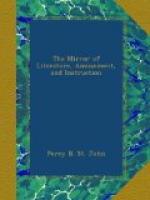In a period of several centuries, during which this relic remained at Constantinople we find it occasionally mentioned in the annals of the time. It was on the Holy Cross that Heracleonas swore to cherish and defend his nephew;[13] it was to the same fragment that the son of Justinian the Second clung for protection, in the revolution which hurled his father from the throne;[14] and we might entertain more respect for the superstition of the Greeks, if the supposed sanctity of this relic had produced either the observance of the oath, or the safety of the suppliant. At length, in the year 1078, the object of this narrative recommenced its travels. A wealthy citizen of Amalfi, whose name is not recorded, had long felt a wish to exchange active life for the cloister, and had selected the monastery of Casinum as the place of his future retirement. Being present in the Eastern capital during the tumultuous deposition of Michael the Seventh, he perceived in the general confusion a favourable opportunity for appropriating this precious fragment to himself. His zeal did not forget at the same time to secure the golden case, richly embossed with jewels, which contained it, and both were laid as a welcome offering before the shrine of St. Benedict, at Casinum.[15] The good fathers must have felt no little pride when strangers beheld, in their secluded and obscure retreat, a relic which a long succession of the most illustrious princes had gloried in possessing.




